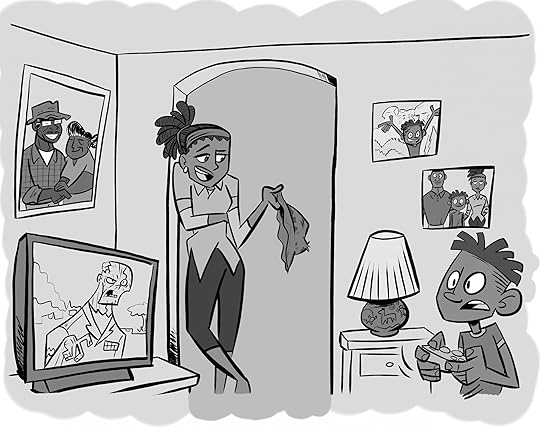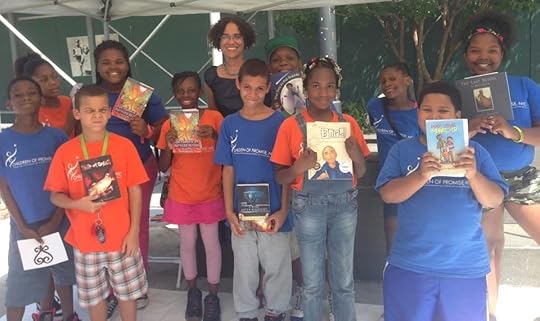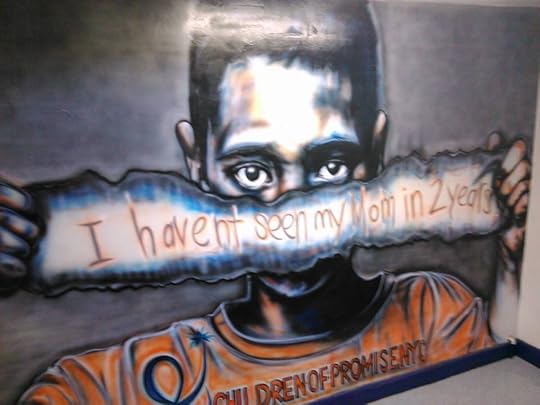Zetta Elliott's Blog, page 43
September 14, 2015
planting seeds
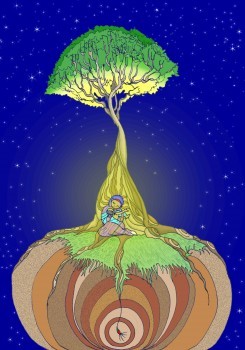 I’ve often written about seeds this past year, so it’s fitting that one of the last books I publish this year, Let the Faithful Come, will feature this gorgeous illustration by Charity Russell. I know some people think it’s unwise to release so many books at once. With the traditional publishing industry, an author sells a manuscript and waits 1-2 years (or more) for the hardcover edition to come out. Then another year passes before the book comes out in paperback. By that point, the author may or may not have another book ready for publication, but that model doesn’t work for me. I’d rather put a book/seed out into the world and trust that over time it will take root and grow. My illustrator in Hong Kong finished up the four remaining illustrations for Billie’s Blues and I think I’m going to release that book this fall as well. That will bring the total number of titles for 2015 to seven, if you include the Spanish translation of Max Loves Muñecas! Too much too soon? Readers, teachers, and librarians are clamoring for diverse books, so how can I justify rationing my titles? Especially when still I’ve got 15 manuscripts sitting on my hard drive. I got another ridiculous rejection letter last week but I also heard from an agent who wants to talk later this month. I’m realistic about my prospects, and will try to stay focused on finishing my novel in progress. Because I know that what’s urgent to me isn’t urgent to everyone else…
I’ve often written about seeds this past year, so it’s fitting that one of the last books I publish this year, Let the Faithful Come, will feature this gorgeous illustration by Charity Russell. I know some people think it’s unwise to release so many books at once. With the traditional publishing industry, an author sells a manuscript and waits 1-2 years (or more) for the hardcover edition to come out. Then another year passes before the book comes out in paperback. By that point, the author may or may not have another book ready for publication, but that model doesn’t work for me. I’d rather put a book/seed out into the world and trust that over time it will take root and grow. My illustrator in Hong Kong finished up the four remaining illustrations for Billie’s Blues and I think I’m going to release that book this fall as well. That will bring the total number of titles for 2015 to seven, if you include the Spanish translation of Max Loves Muñecas! Too much too soon? Readers, teachers, and librarians are clamoring for diverse books, so how can I justify rationing my titles? Especially when still I’ve got 15 manuscripts sitting on my hard drive. I got another ridiculous rejection letter last week but I also heard from an agent who wants to talk later this month. I’m realistic about my prospects, and will try to stay focused on finishing my novel in progress. Because I know that what’s urgent to me isn’t urgent to everyone else…
September 9, 2015
Dayshaun’s Gift
 Last night I wrote an afterword for Dayshaun’s Gift, but this morning I’m thinking it would make a better blog post so I’m pasting it in here. We have a draft cover; I’m not crazy about the color scheme, so we’re going to play around with that, but the book is just about ready to go! I expect to release it on the 15th.
Last night I wrote an afterword for Dayshaun’s Gift, but this morning I’m thinking it would make a better blog post so I’m pasting it in here. We have a draft cover; I’m not crazy about the color scheme, so we’re going to play around with that, but the book is just about ready to go! I expect to release it on the 15th.
***
My grandparents were very proud of their gardens. My father’s parents dug up their front yard so that they’d have more room for growing tomatoes, and they made cider out of the apples that fell from the tree in their backyard. My mother’s parents grew more flowers than I could name as a child, and I still think of my grandmother whenever I see an aster. My mother inherited her parents’ love of flowers, and my father dug up our backyard to plant his own vegetable garden. I grew up in a miniature Eden: there were plum and apple trees, rhubarb and raspberries, tiger lilies and snapdragons, Swiss chard and carrots, and—of course—tomatoes!
Now that I am an adult and a naturalized New Yorker, I realize that though I love city life, I come from a long line of farmers. My mother’s African American ancestors bought their freedom and migrated to Canada sometime before 1820; my great-great-grandfather acquired a farm that stayed in the family for generations. My Caribbean father also came from a family that lived off the land. If I go back far enough on either side of my family, I find ancestors who were forced to work the land as slaves but then chose to continue farming once they were free.
I’m not a gardener but I spend a lot of time in the Brooklyn Botanic Garden and Prospect Park; nature nourishes the soul and provides endless inspiration for a writer like me. But when I left Canada and moved to Brooklyn twenty years ago, I fell in love with the dense urban blocks lined with stately brownstones. Brooklyn felt very modern but there was still clear evidence of its history—something I never found in suburban Toronto. I could walk the streets of Brooklyn and pass churches that had helped fugitive slaves to reach freedom, and there were trees that seemed to be more than a hundred years old. Brooklyn was full of untold stories, and as a storyteller I immediately felt at home.
 While teaching in an afterschool program in Bed-Stuy in 1998, I took a group of 8th graders to the Brooklyn Historical Society where we learned about Maritcha Lyons. Her memoir contained vivid descriptions of the NYC Draft Riots of 1863, and her account of northern mob violence stayed with me for several years until I wrote my first young adult novel, A Wish After Midnight. Maritcha was a teenager when she survived the riots, and my novel is about a contemporary African American teen who opens a portal in the botanic garden and lands in the free Black community of Weeksville just before the Emancipation Proclamation takes effect on January 1, 1863. Seven months later, Genna has to run for her life as the draft riots spread from Manhattan to Brooklyn.
While teaching in an afterschool program in Bed-Stuy in 1998, I took a group of 8th graders to the Brooklyn Historical Society where we learned about Maritcha Lyons. Her memoir contained vivid descriptions of the NYC Draft Riots of 1863, and her account of northern mob violence stayed with me for several years until I wrote my first young adult novel, A Wish After Midnight. Maritcha was a teenager when she survived the riots, and my novel is about a contemporary African American teen who opens a portal in the botanic garden and lands in the free Black community of Weeksville just before the Emancipation Proclamation takes effect on January 1, 1863. Seven months later, Genna has to run for her life as the draft riots spread from Manhattan to Brooklyn.
Slavery ended in 1827 in New York State, so by the time Black families started settling in Weeksville, they were (mostly) free to choose how they wanted to live their lives. I wrote Dayshaun’s Gift after spending two months as the inaugural writer-in-residence at Weeksville Heritage Center during the spring of 2015. I had just completed a picture book about Weeksville and I felt that older kids might appreciate a longer story that blends magic and history. But how could I write about a race riot where whites killed African Americans without terrifying my young readers?
 I decided to write around the riots. Dayshaun is a kid from Brooklyn who loves to blast zombies, but his mom wants him to take an interest in gardening. Because his parents are divorced, Dayshaun spends alternate weekends with his dad who has urged his son to focus on moving forward. But Dayshuan goes back in time when he puts on his grandfather’s grubby old hat; in 1863 he meets two kids from Weeksville, Susan and Teddy, and Dayshaun joins them in helping the survivors of the riots who are camped out in the woods. So Dayshaun sees the terrible consequences of the riots, but the focus is on his ability to act using the knowledge he has gained in the 21st century. He has learned about 9/11 in school and recognizes the same traumatized look on the faces of the survivors. He also stands up for Susan when Teddy tells her she can’t be a doctor because she’s a girl. Susan Smith (right) grew up to become the first African American woman doctor in New York State, and her commitment to serving her community is shown in the novel. The story also touches on the uprisings in Ferguson and Baltimore, and the problem of “food deserts” in many low-income communities.
I decided to write around the riots. Dayshaun is a kid from Brooklyn who loves to blast zombies, but his mom wants him to take an interest in gardening. Because his parents are divorced, Dayshaun spends alternate weekends with his dad who has urged his son to focus on moving forward. But Dayshuan goes back in time when he puts on his grandfather’s grubby old hat; in 1863 he meets two kids from Weeksville, Susan and Teddy, and Dayshaun joins them in helping the survivors of the riots who are camped out in the woods. So Dayshaun sees the terrible consequences of the riots, but the focus is on his ability to act using the knowledge he has gained in the 21st century. He has learned about 9/11 in school and recognizes the same traumatized look on the faces of the survivors. He also stands up for Susan when Teddy tells her she can’t be a doctor because she’s a girl. Susan Smith (right) grew up to become the first African American woman doctor in New York State, and her commitment to serving her community is shown in the novel. The story also touches on the uprisings in Ferguson and Baltimore, and the problem of “food deserts” in many low-income communities.

Illustration by Alex Portal
I read the story over last week and worried that kids might find it boring or preachy. But my trusted friend Kate, who’s a writer and mother of two avid readers, sent me her thoughts about the book this morning and I was so relieved:
I read Dayshaun’s Gift last night. I probably sound like a broken record, but I think it is a great story. It flows well – you are so good at narrative flow. I did not find any typos or things I would change…Love the way you work in so many interesting pieces of history. It’s educational, but in a quiet, interesting and fun way. Your questions for discussion at the end are excellent too. Nice, realistic relationships in the book, great juxtaposing of past and present issues. You address social issues, but also personal ones that kids may struggle with (divorce, friendships, belonging). Kids are really drawn to the comic book illustrations… I think that was a good call to draw in readers.
I’m aiming for a 9/15 release date and will send out another newsletter, so stay tuned! And if you’d like a review copy, just let me know.
September 6, 2015
back-to-school blues
 If I looked back at my September posts for the past five or six years, I suspect I would find that writing about end of summer depression has become an annual tradition. I love to teach so I never really dreaded the start of the fall semester, but when summer ends certain windows close—literally and figuratively. I’m ready for fall weather. As much as I love looking at the crisscrossing tan lines my sandals have left on my feet, I’m ready to bundle up and disappear beneath woolen sweaters and tights. I miss having a cup of tea every day, even though that tends to increase my sugar consumption because I can’t have tea without cookies. I know I have the blues because I haven’t been craving sugar lately; I’ve maintained my Friday cake consumption, but the last slice didn’t really satisfy. I’ve lived with depression and anxiety since I was a teen, so I think about my mood on a regular basis; I’ve never had to hide my condition because some of my friends live with depression, too, and we tend to check in on each other if someone withdraws or otherwise shows sign of distress. But sometimes no one else sees the signs. I had a fairly productive summer: I wrote a middle grade novel, 2 picture book stories, and I added 12,000 words to the sequel that shall not be named. Yesterday I churned out 1500 more words and completed a sixth chapter. That still leaves seven unfinished chapters but it’s progress, right? My sister, who is a psychologist, once told me that mental illness needed to be treated once it started to interfere with a person’s ability to function. But what if depression and anxiety enhance rather than diminish your productivity and creativity? I’ve tried therapy and I would try medication if my mental illness ever did start to interfere with my ability to write. Until then, I’ll continue to shape my life in a way that minimizes stress and maximizes my dream time. I think September gives me the blues because it makes me think about family, the one area of my life where I do feel like a failure. I’m generally okay with being a spinster but when I get the blues, I do look at this writer’s life and wonder if it will always be enough. I manage my anxiety by avoiding many of the things that make me anxious—like my family!—but the universe will only let you dodge your fears for so long. I turn 43 next month and soon won’t have the option of having a baby. I’ve thought about adopting for a long time but I haven’t built a life that could accommodate or provide for a child. So what’s a girl to do? Visit the garden, finish another chapter, and let this annual blue period run its course, I guess.
If I looked back at my September posts for the past five or six years, I suspect I would find that writing about end of summer depression has become an annual tradition. I love to teach so I never really dreaded the start of the fall semester, but when summer ends certain windows close—literally and figuratively. I’m ready for fall weather. As much as I love looking at the crisscrossing tan lines my sandals have left on my feet, I’m ready to bundle up and disappear beneath woolen sweaters and tights. I miss having a cup of tea every day, even though that tends to increase my sugar consumption because I can’t have tea without cookies. I know I have the blues because I haven’t been craving sugar lately; I’ve maintained my Friday cake consumption, but the last slice didn’t really satisfy. I’ve lived with depression and anxiety since I was a teen, so I think about my mood on a regular basis; I’ve never had to hide my condition because some of my friends live with depression, too, and we tend to check in on each other if someone withdraws or otherwise shows sign of distress. But sometimes no one else sees the signs. I had a fairly productive summer: I wrote a middle grade novel, 2 picture book stories, and I added 12,000 words to the sequel that shall not be named. Yesterday I churned out 1500 more words and completed a sixth chapter. That still leaves seven unfinished chapters but it’s progress, right? My sister, who is a psychologist, once told me that mental illness needed to be treated once it started to interfere with a person’s ability to function. But what if depression and anxiety enhance rather than diminish your productivity and creativity? I’ve tried therapy and I would try medication if my mental illness ever did start to interfere with my ability to write. Until then, I’ll continue to shape my life in a way that minimizes stress and maximizes my dream time. I think September gives me the blues because it makes me think about family, the one area of my life where I do feel like a failure. I’m generally okay with being a spinster but when I get the blues, I do look at this writer’s life and wonder if it will always be enough. I manage my anxiety by avoiding many of the things that make me anxious—like my family!—but the universe will only let you dodge your fears for so long. I turn 43 next month and soon won’t have the option of having a baby. I’ve thought about adopting for a long time but I haven’t built a life that could accommodate or provide for a child. So what’s a girl to do? Visit the garden, finish another chapter, and let this annual blue period run its course, I guess.
August 28, 2015
slacker/reset
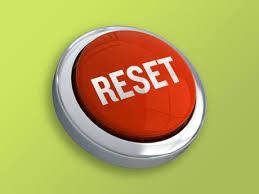 I haven’t written a word for the past two days, but I’m trying not to be too hard on myself. My back’s giving me trouble, sciatica is keeping me up at night, and I’ve gone right back to my old habits after making it through just 2 weeks of my attempted 3-week junk food/fast food fast. Last night I woke at 3am and realized I’d made a mistake in I Love Snow! that will likely set my former English teacher’s hair on edge. None of my pre-publication readers caught it, so maybe my insomnia made the issue larger than it really is. I wasn’t able to fall back to sleep, so I just let my mind ruminate over the possible consequences. Will some librarian or blogger call me out for not hiring an editor to review my books? What does it say about my character if I know about the error but choose not to fix it? Because this is a story I wrote in 2002, there’s a part of me that just wants to let it stand as a testament to how I was writing at the time. And that same part of me knows that kids probably won’t notice or care. I’ve self-published 12 books at this point and three more are in production. Yesterday a librarian in Detroit asked about other books in the City Kids series; I have one that will be ready next month and another that I will try to finish before the winter holidays. With so many new books in progress, I don’t want to agonize about minor imperfections. And I think that is part of my character now. Or maybe I’m finally becoming that person after aiming for—and stressing out about—perfection for most of my life. I also found a small inconsistency in one of the illustrations in A Wave Came Through Our Window but decided to let it stand. It might be fun to ask kids if they can spot it as we read the book aloud. And at the end of the day, I don’t want to be known for writing perfect books (if there even is such a thing). A friend read my recent newsletter and suggested that my name ought to be more prominently displayed on my book covers, but I think picture books largely succeed or fail depending on the illustrations. I’m not trying to minimize my own role, but storytelling succeeds because of a number of different factors. I don’t really remember the books that my mother read to me—I think I grew into an avid reader because I remembered nestling against her large, soft belly and feeling safe, comfortable, and absorbed in another person’s world for at least fifteen minutes each day…
I haven’t written a word for the past two days, but I’m trying not to be too hard on myself. My back’s giving me trouble, sciatica is keeping me up at night, and I’ve gone right back to my old habits after making it through just 2 weeks of my attempted 3-week junk food/fast food fast. Last night I woke at 3am and realized I’d made a mistake in I Love Snow! that will likely set my former English teacher’s hair on edge. None of my pre-publication readers caught it, so maybe my insomnia made the issue larger than it really is. I wasn’t able to fall back to sleep, so I just let my mind ruminate over the possible consequences. Will some librarian or blogger call me out for not hiring an editor to review my books? What does it say about my character if I know about the error but choose not to fix it? Because this is a story I wrote in 2002, there’s a part of me that just wants to let it stand as a testament to how I was writing at the time. And that same part of me knows that kids probably won’t notice or care. I’ve self-published 12 books at this point and three more are in production. Yesterday a librarian in Detroit asked about other books in the City Kids series; I have one that will be ready next month and another that I will try to finish before the winter holidays. With so many new books in progress, I don’t want to agonize about minor imperfections. And I think that is part of my character now. Or maybe I’m finally becoming that person after aiming for—and stressing out about—perfection for most of my life. I also found a small inconsistency in one of the illustrations in A Wave Came Through Our Window but decided to let it stand. It might be fun to ask kids if they can spot it as we read the book aloud. And at the end of the day, I don’t want to be known for writing perfect books (if there even is such a thing). A friend read my recent newsletter and suggested that my name ought to be more prominently displayed on my book covers, but I think picture books largely succeed or fail depending on the illustrations. I’m not trying to minimize my own role, but storytelling succeeds because of a number of different factors. I don’t really remember the books that my mother read to me—I think I grew into an avid reader because I remembered nestling against her large, soft belly and feeling safe, comfortable, and absorbed in another person’s world for at least fifteen minutes each day…
 I had tea with friends last night and we talked about the steps we take to sustain our productivity as writers. I realize I might seem prolific to others, and just read a brilliant essay by another friend about how our Facebook posts can create a false image of the writer’s life. It isn’t as glamorous or fun as our photos and announcements might suggest, and this can be especially misleading for emerging writers who look to elders for an example of how to live in the world as a working artist. It’s Friday night and I’m doing laundry while blogging so that I can at least claim I did *some* writing today. Next I’ll go back to the novel-in-progress and try to stop grumbling about how this book feels like a chattering monkey I can’t get off my back. I’ve been cursing a lot lately and that likely won’t stop until I’m back in the classroom and this novel is finally done. I have managed to run in the park every other day, and will get back to my stretches so that the sciatica/back pain doesn’t make sitting in front of the computer such a pain. I’m going to try a 4-day cleanse that worked for a friend of mine; I don’t have all the food on the limited menu (and I hate fish so that’s not going to happen everyday), but I’m still going to give it a try. And if cake happens again next Friday, so be it. I’m human!
I had tea with friends last night and we talked about the steps we take to sustain our productivity as writers. I realize I might seem prolific to others, and just read a brilliant essay by another friend about how our Facebook posts can create a false image of the writer’s life. It isn’t as glamorous or fun as our photos and announcements might suggest, and this can be especially misleading for emerging writers who look to elders for an example of how to live in the world as a working artist. It’s Friday night and I’m doing laundry while blogging so that I can at least claim I did *some* writing today. Next I’ll go back to the novel-in-progress and try to stop grumbling about how this book feels like a chattering monkey I can’t get off my back. I’ve been cursing a lot lately and that likely won’t stop until I’m back in the classroom and this novel is finally done. I have managed to run in the park every other day, and will get back to my stretches so that the sciatica/back pain doesn’t make sitting in front of the computer such a pain. I’m going to try a 4-day cleanse that worked for a friend of mine; I don’t have all the food on the limited menu (and I hate fish so that’s not going to happen everyday), but I’m still going to give it a try. And if cake happens again next Friday, so be it. I’m human!
August 25, 2015
miss me?
My first newsletter went out over the weekend. If it didn’t arrive in your inbox, please check your spam or promotions folder; if you would like to join my mailing list, please use the box to the right. The newsletter can be viewed here. My two new picture books, I Love Snow! and A Wave Came Through Our Window, can also be purchased as e-books in the Kindle Store.
Last night I wrote over 600 words and that pushed me past the 100,000-word mark on this novel. I’m somewhat obsessed with my progress, so it was troubling to find that as soon as I hit six figures, MS Word stopped displaying my word count! Maybe that’s the universe’s way of telling me to stop counting and just keep writing…
My illustrator for Dayshuan’s Gift, a middle grade time-travel novel, sent the first four finished illustrations last night. The book covers some serious subjects—divorce, food deserts, and race riots—so at first I wanted the illustrations to make my characters look serious and “dignified.” But I later decided to go in a different direction, and I think Alex has done a good job making the characters look fun and appealing to kids. Here’s the back cover blurb for Dayshaun’s Gift:
Summer vacation has just begun and Dayshaun wants to spend Saturday morning playing his new video game. But Dayshaun’s mother has other plans: she volunteers at a nearby community garden and that means Dayshaun has to volunteer, too. When Dayshaun puts on his grandfather’s grubby old gardening hat, something unexpected happens—the hands of time turn backward and Dayshaun finds himself in the free Black community of Weeksville during the summer of 1863! While helping the survivors of the New York City Draft Riots, Dayshaun meets a frail old man who entrusts him with a precious family heirloom. But will this gift help Dayshaun find his way back to the 21st century?
My illustrator in Hong Kong is almost done with Billie’s Blues—just one more illustration to go! And Charity has finished half the sketches for our Xmas book, Let the Faithful Come. She’s drawing inspiration from the refugee crisis in the Mediterranean. More details will be in the next newsletter so if you’re not on my mailing list, sign up now!
August 22, 2015
wade in the water
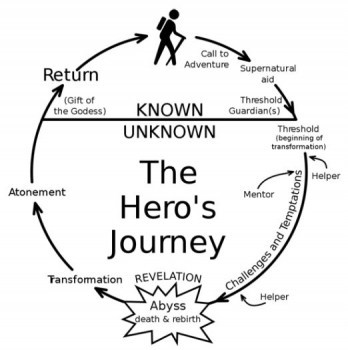 A friend of mine wants to start a writing group to discuss “craft.” I balked immediately—can’t we just get together, talk shop, and eat cake? I’m the only person in this group, I think, who doesn’t have an MFA. I took (and failed) a creative writing class in high school; I tried again in college during my study abroad semester in England, and wound up winning the writing prize that year. But I’ve never been a formalist and another professor friend once accused me of teaching African American literature as a history course. Guilty as charged—I’m not that interested in the placement of a comma in the middle of a line of verse. I prefer to talk about themes and originality and dramatic tension, and whether or not a storyteller grabbed my attention. Talking about a story’s structure makes literature start to feel more like math; even if there is a formula for writing a good book, I don’t want to know what it is. I’d rather jump into the ocean and flounder until I make my way back to shore. I can swim; I learned a number of different strokes when I was a kid, but I’m not graceful or fast in the water. And I don’t need to be. I just need to stay afloat and get where I’m trying to go.
A friend of mine wants to start a writing group to discuss “craft.” I balked immediately—can’t we just get together, talk shop, and eat cake? I’m the only person in this group, I think, who doesn’t have an MFA. I took (and failed) a creative writing class in high school; I tried again in college during my study abroad semester in England, and wound up winning the writing prize that year. But I’ve never been a formalist and another professor friend once accused me of teaching African American literature as a history course. Guilty as charged—I’m not that interested in the placement of a comma in the middle of a line of verse. I prefer to talk about themes and originality and dramatic tension, and whether or not a storyteller grabbed my attention. Talking about a story’s structure makes literature start to feel more like math; even if there is a formula for writing a good book, I don’t want to know what it is. I’d rather jump into the ocean and flounder until I make my way back to shore. I can swim; I learned a number of different strokes when I was a kid, but I’m not graceful or fast in the water. And I don’t need to be. I just need to stay afloat and get where I’m trying to go.
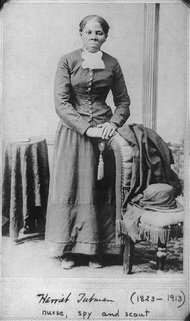 The hardest part about writing a sequel is making sure you don’t drop the ball when it comes to continuity. I threw out a bunch of southern states when I was writing A Wish After Midnight—Genna learns near the end of the novel that Judah’s journey led him from NYC into the deep South. But I didn’t really think about HOW I would get Judah there and back, and doing research in South Carolina a couple of years ago didn’t really help. I stayed in a lovely hotel in Charleston, visited the old slave market, and took a bus tour of the sea island plantations. But none of that taught me what it would be like to run for miles on foot with slave catchers on your trail in the middle of the Civil War. So now I’m trying to find facts that support my fiction. Would it have been easier if I had plotted both novels before starting to write? Probably. I do use a fairly detailed outline, but sometimes I just throw a ball into the air and assume I’ll be able to catch it later on. So I took Judah from New York to Virginia to South Carolina to Georgia, and now I need to place him along the banks of the Combahee River back in South Carolina so that he can be saved by Harriet Tubman during her rescue of over 700 enslaved people during an 1863 Union raid. No problem, right? I have to have this scene in the book because I’ve seen—and cherished—the word Combahee for decades, ever since reading the 1977 statement by the Black feminist Combahee River Collective. Judah is anything BUT a feminist, but this connection matters to me so I’m exercising my author’s prerogative. I’ve finished 4 chapters so far this month but that leaves 8 that still need work. I’m kicking and splashing and choking sometimes, but I’m still keeping my head above water…
The hardest part about writing a sequel is making sure you don’t drop the ball when it comes to continuity. I threw out a bunch of southern states when I was writing A Wish After Midnight—Genna learns near the end of the novel that Judah’s journey led him from NYC into the deep South. But I didn’t really think about HOW I would get Judah there and back, and doing research in South Carolina a couple of years ago didn’t really help. I stayed in a lovely hotel in Charleston, visited the old slave market, and took a bus tour of the sea island plantations. But none of that taught me what it would be like to run for miles on foot with slave catchers on your trail in the middle of the Civil War. So now I’m trying to find facts that support my fiction. Would it have been easier if I had plotted both novels before starting to write? Probably. I do use a fairly detailed outline, but sometimes I just throw a ball into the air and assume I’ll be able to catch it later on. So I took Judah from New York to Virginia to South Carolina to Georgia, and now I need to place him along the banks of the Combahee River back in South Carolina so that he can be saved by Harriet Tubman during her rescue of over 700 enslaved people during an 1863 Union raid. No problem, right? I have to have this scene in the book because I’ve seen—and cherished—the word Combahee for decades, ever since reading the 1977 statement by the Black feminist Combahee River Collective. Judah is anything BUT a feminist, but this connection matters to me so I’m exercising my author’s prerogative. I’ve finished 4 chapters so far this month but that leaves 8 that still need work. I’m kicking and splashing and choking sometimes, but I’m still keeping my head above water…
August 21, 2015
not a birthday, but a beginning
![Pageflex Persona [document: PRS0000420_00047]](https://i.gr-assets.com/images/S/compressed.photo.goodreads.com/hostedimages/1439122770i/15797434.jpg) Since most of my stories were written more than decade ago, finally holding a hard copy in my hands doesn’t exactly feel like a victory. I’m proud of my books, and I think they’re getting better as I learn more about self-publishing and finding the right illustrator. And I will be having cake today! But I’m not making a big fuss about this “book birthday.” It’s just the beginning, really, because now I have to send out review copies and I’m trying my hand at a Mailchimp newsletter—all while finishing my novel and collaborating with illustrators on three more books! And there are all the challenges that come with self-publishing—no reviews in major outlets, limited acquisition by libraries, the struggle to get the word out. But for now I’m going to enjoy this part of the journey. My stories went from my imagination to my hard drive, and now they’re out there in the world. Enjoy!
Since most of my stories were written more than decade ago, finally holding a hard copy in my hands doesn’t exactly feel like a victory. I’m proud of my books, and I think they’re getting better as I learn more about self-publishing and finding the right illustrator. And I will be having cake today! But I’m not making a big fuss about this “book birthday.” It’s just the beginning, really, because now I have to send out review copies and I’m trying my hand at a Mailchimp newsletter—all while finishing my novel and collaborating with illustrators on three more books! And there are all the challenges that come with self-publishing—no reviews in major outlets, limited acquisition by libraries, the struggle to get the word out. But for now I’m going to enjoy this part of the journey. My stories went from my imagination to my hard drive, and now they’re out there in the world. Enjoy!
August 19, 2015
afterword
 Lately I’ve been writing at the very end of the day (except for Sunday when I didn’t leave the house and churned out 1500 words). The goal is to write 500 words a day for the month of August, but right now I’m at 6500 when I should be at 8500. Some progress is better than no progress at all, and I’m trying to be forgiving when I fall short or miss a day. I realize I’m making things harder because I’m trying to finish chapters in sequence and won’t let myself jump ahead when I get stuck. I just stay there, staring at the screen, until I find a way to fill in the blank. Then I get up and do some stretches or have a snack (more snacking than stretching, unfortunately, now that my sugar fast has ended). Today I’m thinking about the afterword I need to write for one of my forthcoming picture books, Billie’s Blues. I keep referring to it as “my lynching book,” but it’s really about the Great Migration. There is one illustration at the end, however, that points to the racial violence that prompted so many African Americans to pack up and move. I’m working with my amazing Hong Kong illustrator again and she just sent me this sketch, which was inspired by two Jacob Lawrence paintings I sent her for reference. Have you ever talked to your kids about lynching? When I first taught my course on gender, terror, and trauma at Ohio University in 2002, my students were angry that they were only learning about lynching in college when they had
Lately I’ve been writing at the very end of the day (except for Sunday when I didn’t leave the house and churned out 1500 words). The goal is to write 500 words a day for the month of August, but right now I’m at 6500 when I should be at 8500. Some progress is better than no progress at all, and I’m trying to be forgiving when I fall short or miss a day. I realize I’m making things harder because I’m trying to finish chapters in sequence and won’t let myself jump ahead when I get stuck. I just stay there, staring at the screen, until I find a way to fill in the blank. Then I get up and do some stretches or have a snack (more snacking than stretching, unfortunately, now that my sugar fast has ended). Today I’m thinking about the afterword I need to write for one of my forthcoming picture books, Billie’s Blues. I keep referring to it as “my lynching book,” but it’s really about the Great Migration. There is one illustration at the end, however, that points to the racial violence that prompted so many African Americans to pack up and move. I’m working with my amazing Hong Kong illustrator again and she just sent me this sketch, which was inspired by two Jacob Lawrence paintings I sent her for reference. Have you ever talked to your kids about lynching? When I first taught my course on gender, terror, and trauma at Ohio University in 2002, my students were angry that they were only learning about lynching in college when they had  studied the Holocaust as children. Few had studied slavery in school, though most had done a Social Studies unit on the Civil Rights Movement. So what do you say to a child about lynching without leaving her terrified? What do you say about police brutality without making your child afraid to turn to a copy when in crisis? I’ve been having these conversations with friends for a while now. I don’t have children but I’m an educator and an auntie, and I feel an obligation as a writer to “teach the youth the truth.” Not the whole truth, and not all the time. A 5-year-old isn’t ready for a conversation about lynching. But an 8-year-old IS ready to talk about the way justice is subverted by mob violence. College students can handle the graphic, gruesome details of lynching, but that doesn’t mean younger children shouldn’t be exposed to this part of US history. Billie’s Blues is mostly about a little girl spending
studied the Holocaust as children. Few had studied slavery in school, though most had done a Social Studies unit on the Civil Rights Movement. So what do you say to a child about lynching without leaving her terrified? What do you say about police brutality without making your child afraid to turn to a copy when in crisis? I’ve been having these conversations with friends for a while now. I don’t have children but I’m an educator and an auntie, and I feel an obligation as a writer to “teach the youth the truth.” Not the whole truth, and not all the time. A 5-year-old isn’t ready for a conversation about lynching. But an 8-year-old IS ready to talk about the way justice is subverted by mob violence. College students can handle the graphic, gruesome details of lynching, but that doesn’t mean younger children shouldn’t be exposed to this part of US history. Billie’s Blues is mostly about a little girl spending 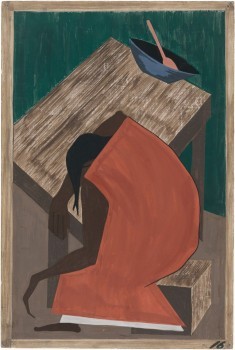 a fun afternoon with an elderly neighbor—they listen to blues records and dress up in vintage clothes. But then Ms. Marble tells Billie why she left the South:
a fun afternoon with an elderly neighbor—they listen to blues records and dress up in vintage clothes. But then Ms. Marble tells Billie why she left the South:
The moon turned red the night they came
and took my Jim away.
The moon burned red the night they came
and took my Jim away.
Now that they done took my man,
there’s no reason to stay.
Make a point. Open a door. Start a conversation. That’s what I want my books to do…
August 15, 2015
the door at the crossroads
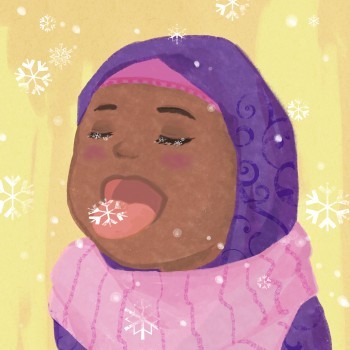 I’m trying out new titles for the sequel to A Wish After Midnight. My plan was to write 500 words each day, which would produce 15,000 words by the end of the month. I’m behind, of course, but wrote close to a thousand words late last night and still believe I CAN finish this novel in a couple of weeks. Did you notice that summer’s almost over? I’ve started scheduling school visits for the fall, and the leaves in Brooklyn have already started to turn color and lie crisp on the sidewalk. I’ll be in Baltimore for Kidlitcon 2015 and hope to see you there—check out the great program. I’m honored to be on a panel with three other women of color bloggers and authors.
I’m trying out new titles for the sequel to A Wish After Midnight. My plan was to write 500 words each day, which would produce 15,000 words by the end of the month. I’m behind, of course, but wrote close to a thousand words late last night and still believe I CAN finish this novel in a couple of weeks. Did you notice that summer’s almost over? I’ve started scheduling school visits for the fall, and the leaves in Brooklyn have already started to turn color and lie crisp on the sidewalk. I’ll be in Baltimore for Kidlitcon 2015 and hope to see you there—check out the great program. I’m honored to be on a panel with three other women of color bloggers and authors.
Intersectionality: The Next Step in Diverse Books
The need for diversity in books has never been clearer as readers clamor for stories about underrepresented characters. But diversity can’t be understood through a single lens. Nor can different types of underrepresented experiences be considered independently from each other. This panel will discuss the need for intersectionality in books, and how it can take the diverse books movement to the next level.
Panelists:
Libertad Araceli Thomas (Twinja Book Reviews)
Guinevere Zoyana Thomas (Twinja Book Reviews)
Mary Fan (Flynn Nightsider)
Zetta Elliott (The Deep)
I’ve been talking about and teaching intersectionality for some time now, and am looking forward to selecting examples from my books for young readers. The latest is I Love Snow! which isn’t quite ready but should be available for purchase in a day or two. This is one of my favorite illustrations by Purple Wong. I felt it was important to have as many different kinds of kids included in this book about winter in Brooklyn. It’s also meant to be a tribute to Ezra Jack Keats’ The Snowy Day, which was the first book to reflect my Black, Afro-ed, snow-loving child self. I know what it’s like to feel invisible and so I try to write about the kids who might also feel that way–Black Muslims, Afro-Latinos, Black kids living with disabilities, Black queer youth. I write about kids with various family configurations. Kids who live at multiple intersections of identity in a world that prefers simple binaries. Last Wednesday I gave a reading at the Marcy Plaza Farmer’s Market; the event was organized by the Bed-Stuy Restoration Corporation and I was thrilled that coordinator Tracey Capers invited kids from Children of Promise, NYC, a nonprofit that provides services for kids who have an incarcerated parent. Nearly 3 million kids in the US have a parent in prison, but where are the books that reflect their reality? Everyone has a story to tell and every story reflects a unique point of view. I want my books to reflect the diversity within the Black community because ALL Black Lives Matter.
August 11, 2015
black and (jet)blue
What did I do to be so black and blue?
“Do the best you can until you know better. Then when you know better, do better” ~ Maya Angelou
 On Sunday I was over at a friend’s house for our monthly gathering of Black women writers. When it comes to diversity in kid lit, we occupy different positions across the spectrum, but it’s useful to discuss the respective challenges we face when trying to create change within the children’s publishing industry. For example, when you’re part of a team, it can be hard to build consensus around a specific agenda—and even harder to divide the labor so that the onus doesn’t fall on one person. Our conversations tend to jump around a lot; as writers, we also talk about our works-in-progress and when Jenn went online to show us an illustrator’s portfolio, she learned that a friend of ours had suddenly passed away. The news of Brook Stephenson‘s death completely changed the tone of our conversation. Like us, Brook was a writer, educator, and a passionate advocate for greater diversity in the literary world. He supported writers of color in every possible way, and it was devastating to learn that his life—and his life’s work—ended so abruptly. We all know that tomorrow isn’t promised, but we don’t always treat our projects with the urgency they deserve. I was asked recently whether I would ever consider going the traditional route with my manuscripts. And I didn’t have the energy to explain that I do send things out to agents and editors but rarely receive a response. I didn’t set out to self-publish, but I don’t have any regrets. I should have two new books ready by the end of this week, and I have three more in production. If, God forbid, I didn’t wake up tomorrow, I would at least leave behind two dozen books that can continue to circulate and reflect my view of the world.
On Sunday I was over at a friend’s house for our monthly gathering of Black women writers. When it comes to diversity in kid lit, we occupy different positions across the spectrum, but it’s useful to discuss the respective challenges we face when trying to create change within the children’s publishing industry. For example, when you’re part of a team, it can be hard to build consensus around a specific agenda—and even harder to divide the labor so that the onus doesn’t fall on one person. Our conversations tend to jump around a lot; as writers, we also talk about our works-in-progress and when Jenn went online to show us an illustrator’s portfolio, she learned that a friend of ours had suddenly passed away. The news of Brook Stephenson‘s death completely changed the tone of our conversation. Like us, Brook was a writer, educator, and a passionate advocate for greater diversity in the literary world. He supported writers of color in every possible way, and it was devastating to learn that his life—and his life’s work—ended so abruptly. We all know that tomorrow isn’t promised, but we don’t always treat our projects with the urgency they deserve. I was asked recently whether I would ever consider going the traditional route with my manuscripts. And I didn’t have the energy to explain that I do send things out to agents and editors but rarely receive a response. I didn’t set out to self-publish, but I don’t have any regrets. I should have two new books ready by the end of this week, and I have three more in production. If, God forbid, I didn’t wake up tomorrow, I would at least leave behind two dozen books that can continue to circulate and reflect my view of the world.
 And what about all the time and energy I have devoted to the diversity debate? I feel less certain of my impact in that arena. This morning a friend at a conference in the UK tweeted that children’s literature scholar Phil Nel was talking about my books and the link between racism and self-publishing. Over the weekend, another friend gave the keynote at this same conference and also referenced my work. I’m blessed to have bold allies who use their platforms to call a spade a spade—the overwhelming whiteness of the children’s literature community isn’t about merit (writers of color aren’t talented enough) or money (books about kids of color don’t sell). It’s about power (who hoards it) and priorities (what matters most to those with the most power).
And what about all the time and energy I have devoted to the diversity debate? I feel less certain of my impact in that arena. This morning a friend at a conference in the UK tweeted that children’s literature scholar Phil Nel was talking about my books and the link between racism and self-publishing. Over the weekend, another friend gave the keynote at this same conference and also referenced my work. I’m blessed to have bold allies who use their platforms to call a spade a spade—the overwhelming whiteness of the children’s literature community isn’t about merit (writers of color aren’t talented enough) or money (books about kids of color don’t sell). It’s about power (who hoards it) and priorities (what matters most to those with the most power).
When I met with the Black women behind the Soar with Reading program last Friday, I knew I was preaching to the choir. We posted our open letter to Jet Blue last month with the hope that the company would reach out to us, but I didn’t expect to receive a personal invitation to meet with Icema Gibbs, Jet Blue’s Director of Corporate Social Responsibility. At their Long Island City headquarters I had an hour to share my concerns with Ms. Gibbs and Tamara Young, Manager of Corporate Communications, and I really appreciated their candor and willingness to consider the suggested actions our group put together.
Solicit diverse books from small presses and independent authors
Deepen engagement with books by providing opportunities for children to meet local authors of color
Promote book culture on Jet Blue flights and social media with PSAs featuring authors and/or celebrity parents offering tips for promoting family literacy
Partner with Ikea or Home Depot to provide simple bookcases so families can create a reading nook in their home
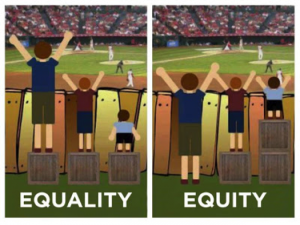 Jet Blue’s commitment to providing 100,000 books to children in low-income communities is admirable and we certainly don’t want to see the program fail. But gauging its success depends on the initial objectives. We support the development of home libraries and know how hard it can be to purchase books in low-income areas. We also understand the importance of providing “mirrors” when trying to deepen a child’s engagement with books. It is undoubtedly cheaper to partner with a large corporate publisher that can provide thousands of deeply discounted titles for the book vending machines. But when the vast majority of those titles don’t reflect the children receiving the books, what has been achieved and what has been lost? I’m not a corporate kind of girl and will let someone else do the cost-benefit analysis here. But personally, I would opt for equity and quality over quantity—if necessary, spend more money on fewer books to ensure that they don’t contribute to the symbolic and physical annihilation of our most vulnerable kids of color. When possible, feature local authors so kids understand that a writer is someone who looks just like them and comes from their community. Don’t give a leg up to corporate publishers and white authors who already consume 95% of the pie—and don’t prioritize the needs of kids of color.
Jet Blue’s commitment to providing 100,000 books to children in low-income communities is admirable and we certainly don’t want to see the program fail. But gauging its success depends on the initial objectives. We support the development of home libraries and know how hard it can be to purchase books in low-income areas. We also understand the importance of providing “mirrors” when trying to deepen a child’s engagement with books. It is undoubtedly cheaper to partner with a large corporate publisher that can provide thousands of deeply discounted titles for the book vending machines. But when the vast majority of those titles don’t reflect the children receiving the books, what has been achieved and what has been lost? I’m not a corporate kind of girl and will let someone else do the cost-benefit analysis here. But personally, I would opt for equity and quality over quantity—if necessary, spend more money on fewer books to ensure that they don’t contribute to the symbolic and physical annihilation of our most vulnerable kids of color. When possible, feature local authors so kids understand that a writer is someone who looks just like them and comes from their community. Don’t give a leg up to corporate publishers and white authors who already consume 95% of the pie—and don’t prioritize the needs of kids of color.
So where do we go from here? The pilot program for the book vending machines wraps up in October, and other cities are already competing for a chance to have 100,000 books donated to their communities. New York isn’t a contender right now, and I’m not sure whether we should mobilize people to vote when it’s unclear what the vending machines will offer next year. Should we write another open letter to Random House and demand that they provide more diverse books for the Soar with Reading program? Or should we take a page out of the Black Lives Matter movement and grab the mic at a public event? People don’t always do better when they know better, and the energy we spend appealing to corporations is energy we’re not investing in our own work. Tomorrow isn’t promised. So what should we do TODAY?

